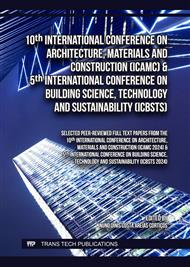p.33
p.41
p.47
p.55
p.65
p.73
p.83
p.95
p.103
Role of Window-Integrated BIPV for Building Daylight Performance in Composite Climate
Abstract:
It is feasible to add the function of energy generation to a typical building fenestration component by inserting photovoltaics within windows. Electrical power can undoubtedly be generated on-site. The influence of PV windows on the interior lighting environment of the region they serve, on the other hand, has yet to be well studied. This paper presents the potential impact of semi-transparent photovoltaic windows on the daylighting performance of an institutional building window. Transparent PV solar cells capture and use undesired light energy via windows in buildings and are incorporated with existing window panes. This affects the overall power and natural daylight penetrating the indoor space. Integrating si-based, opaque-spaced cells with transparent thin film technologies, the performance of three façade configurations is investigated concerning their luminance level during the summer seasons of a composite climate, followed by simulations of a semi-transparent PV module, which is possible through radiation. This report presents a study that will provide enough evidence to broaden the development of solar cells integrated with windows for added clean energy production and the advancement of daylight luminance.
Info:
Periodical:
Pages:
65-72
Citation:
Online since:
January 2025
Authors:
Keywords:
Price:
Сopyright:
© 2025 Trans Tech Publications Ltd. All Rights Reserved
Share:
Citation:


